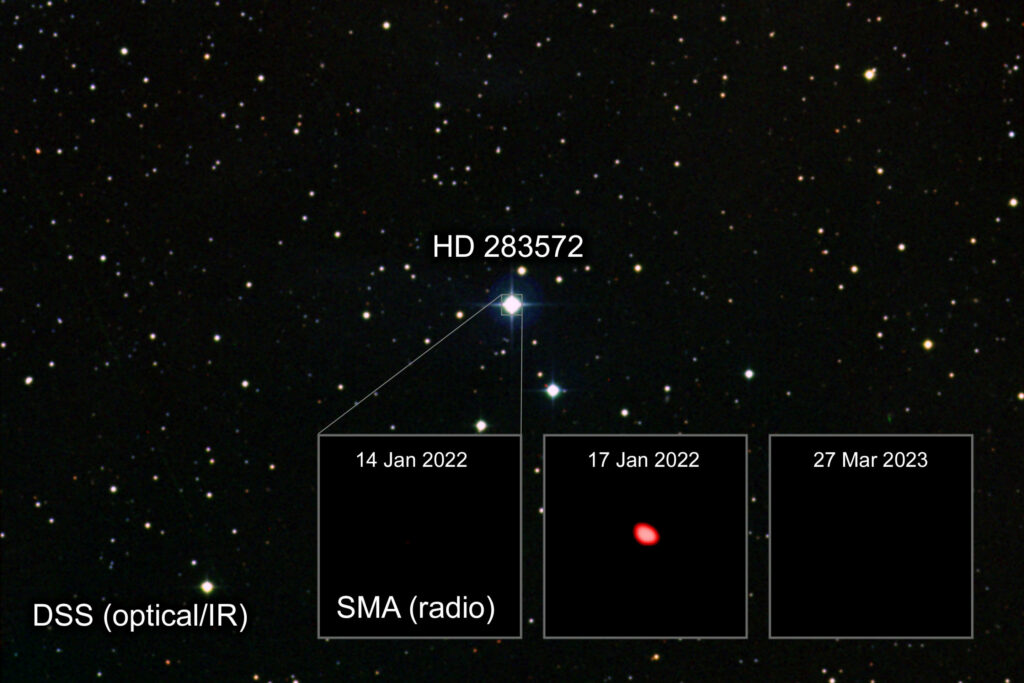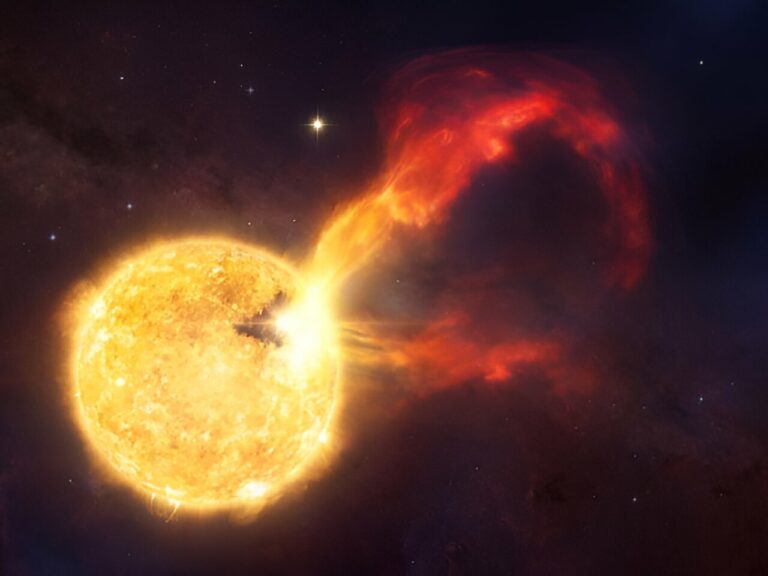Fierce Outburst from Sun-Like Star Suggests Harsh Conditions for Forming Exoplanets
A young star, known as HD 283572, has recently undergone an extreme eruption that caused it to become more than a hundred times brighter in just a few hours. This remarkable discovery has provided astronomers with valuable insights into the behavior of young sun-like stars during their early stages of development, as well as their influence on the formation of newly born planets.
The research team, led by scientists from the Smithsonian Astrophysical Observatory (SAO) and the Center for Astrophysics | Harvard & Smithsonian (CfA), made this breakthrough using the Submillimeter Array (SMA) located on Mauna Kea in Hawaii. The SMA is a collection of telescopes specifically designed to detect millimeter-wave light.
HD 283572, which is approximately 3 million years old, is significantly younger than our own sun and is at the stage where Earth-like planets typically begin to form around stars. The team, led by Dr. Joshua Bennett Lovell, an SAO astronomer and SMA Fellow at CfA, initially used the SMA to search for the faint glow of dust particles associated with the formation of young planets. However, they were taken aback when they observed an incredibly bright flare from the star instead.
Lovell expressed their surprise, stating, “We were not expecting to witness such a bright flare from a young star. Flares of this magnitude at these wavelengths are uncommon, as we had anticipated only detecting the faint glow of dust involved in planet formation.”
Stellar flares can cause a significant increase in a star’s brightness across various wavelengths of light. As stars rotate, their magnetic fields can become tightly wound and develop areas of heightened magnetic energy. Eventually, this stored energy is released, resulting in the acceleration of charged particles that erupt through the star’s surface.
This extraordinary eruption from HD 283572 has provided astronomers with a unique opportunity to study the behavior of young stars and their potential impact on the development of planets in their vicinity. The findings from this research will contribute to our understanding of the early stages of star and planet formation, shedding light on the intricate processes that shape our universe.
It can be quite difficult to observe flares due to the uncertainty of when a star will flare again, especially at millimeter wavelengths. Lovell mentioned that HD 283572 remained inactive for several months before its eruption was detected. Interestingly, every time the SMA was directed towards the star after the flare, no activity was observed.
This confirms that flare events are infrequent at millimeter wavelengths, but when they do occur, they can be remarkably intense for stars in their early stages.

The flare of HD 283572 was measured by the team, and it was discovered that it released an astonishing amount of energy over a period of 9 hours. In fact, it emitted approximately a million times more energy than any flares observed on the sun’s nearest stellar neighbors. This makes it one of the most powerful flares ever recorded.
According to Dr. Garrett Keating, a researcher from SAO and the second author of the study, this event was of immense magnitude. He compared it to the Earth’s entire nuclear arsenal being expended in a matter of milliseconds, repeatedly, for almost half a day. Furthermore, Dr. Keating mentioned that if they take into account the wavelengths of the star’s light that were not observed by the SMA, it is possible that the flare was even more energetic than initially estimated.
However, despite the significance of this event, the exact cause of the flare remains uncertain. Dr. Keating explained that there are various potential mechanisms that could have triggered it, such as interactions with unseen companion stars or planets, or periodic starspot activity. Nevertheless, what is undeniable is the sheer power of this event. Dr. Keating emphasized that any planets in this system would have been severely impacted by the intense energy of the flare, making it an inhospitable environment for life to develop.
The star’s youthful age and its resemblance to our own sun offer valuable insights into the potential conditions that young planets like Earth might encounter. These findings suggest that intense flares could impede the development of planetary atmospheres or cause significant damage to already formed atmospheres.
Ongoing observations aim to shed light on the frequency of flaring activity in HD 283572 and whether such flares hinder the growth of planetary atmospheres around similar young stars.
Ramisa Akther Rahman, a senior undergraduate from the College of William and Mary who participated in the SAO’s Research Experience for Undergraduates program as a summer intern in 2023, shared, “We are currently conducting a new SMA campaign to investigate young stars resembling HD283572. Our goal is to determine the frequency of flares and understand their typical characteristics. Additionally, by combining SMA data with observations at longer wavelengths, we can delve into the physics behind flares and their emission mechanisms. I have personally worked on this using archival data from the Very Large Array.”
The findings have been published in The Astrophysical Journal Letters.
This article is republished from PhysORG under a Creative Commons license. Read the original article.
Do not forget to share your opinion with us to provide you with the best posts !




0 Comments